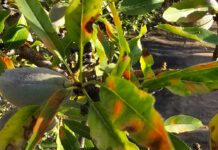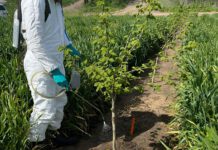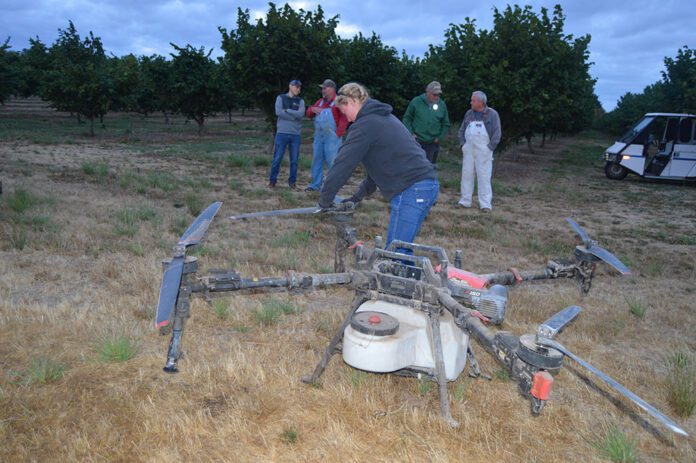
Listen to the audio version of this article. (Generated by A.I.)
A pest that has emerged as a threat to Oregon hazelnuts is facing a new combatant. The brown marmorated stink bug (BMSB) is now under attack from drones.
Researchers are studying whether drones, in combination with low-volume attract-and-kill spray formulations, can provide an effective control option for the pest. The formula is widely used in blueberries against the spotted wing drosophila. If researchers can show it is also effective against BMSB in hazelnuts, growers may be able to come in with late-season treatments without the risk of knocking off nuts and injuring limbs.
Native to Asia, BMSB started appearing in Oregon hazelnuts as early as six years ago, said Angel Torres, specialty crop manager for Pratum Co-op, a Salem-based full-service agricultural retailer who is working with Oregon State University (OSU) on the research.
“You’d see them in the orchard but never to the level of pressure that caused concern. Then three years ago it started raising alarms,” Torres said.
Over the past year, Oregon State University Extension entomologist Vaughn Walton said he has seen where BMSB has caused as much as 20% yield loss in Oregon hazelnut orchards. Elsewhere, such as in Turkey, growers have lost 100% of their hazelnut crop to BMSB in some cases, Walton said.
Hazelnut producer Bill Bentley, who has volunteered his orchard for the research, said he started noticing stink bug damage two years ago.
“I started noticing a lot of nut drop and blank nuts,” Bentley said. “So, I called Vaughn and said I think I have a problem. They came out and said, ‘Yeah, you do.’”
BMSB damages hazelnuts by penetrating shells with their stylets and feeding on kernels. Typical symptoms include malformed or shriveled nuts, brown-stained nuts and blank nuts.
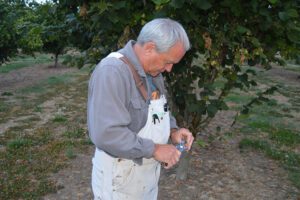
Generalist Insects
Unlike the filbert worm which keys on hazelnuts and hazelnuts alone, BMSB has a wide host range and will feed on hundreds of plant species, making it difficult to isolate and control.
“These insects are generalists so usually they are feeding on multiple different species of plants and it is unclear whether they can complete their entire life cycle on hazelnut and whether they can do that equally well from the beginning of the season to the end,” Walton said. “Throughout the growing season they are going to be moving around to feed on different hosts that are at preferred phenological stages of development.”
BMSB typically overwinters in structures before emerging to attack plants in the spring and summer. In Bentley’s case, the stink bug appears to be overwintering in a barn adjacent to a 9-year-old orchard of the McDonald cultivar and then moving into the orchard when temperatures warm.
In experiments, Walton is attempting to answer which phenological stage of hazelnut the stink bug prefers. To date, his research is showing that the mid- to late-season stage is most attractive in that the stink bug is better able to complete its life cycle when feeding on hazelnuts at that time of year.
Walton has also shown that the cultivars Clark, Sacagawea and Yamhill are more suitable to supporting the development of BMSB than Barcelona, a thicker-shelled cultivar.
“We found that for the adult BMSB, shell thickness really doesn’t matter,” Walton said. “They can feed equally as well on the thick-shelled cultivars as the thin-shelled ones. But it is possible that a thick-shelled hazelnut cultivar could have a shell that is thick enough to prevent the young nymphs from reaching the kernel.”
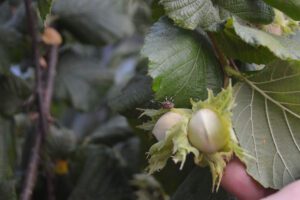
Three Treatments
Under the experiment in Bentley’s orchard, researchers are applying three treatments of the attractant Combi-Protec mixed with the insecticide Delegate at one-week intervals beginning with an application on August 7.
The idea is the attractant, which includes fatty acids that the stink bug feeds on, will draw the bug to the insecticide. “The stink bug will take in the attractant laced with toxicant,” Walton said.
Researchers are collecting nuts on a weekly basis from mid-August through harvest, eight sampling dates in all, and measuring damage levels.
“We’re doing 5 gallons an acre with the drone compared to 100 gallons an acre with an airblast sprayer.”
– Vaughn Walton, Oregon State University
OSU researchers also are gauging the effectiveness of the formula at Lewis-Brown Farm, a research farm in Corvallis.
“That will be more controlled,” Walton said. “We will know the insect count beforehand.”
Among parameters being analyzed, researchers are trying to determine optimum spray droplet size, optimum spray timing, insecticide efficacy and application rate.
In the treatment applied August 7, researchers mixed 7 ounces of Combi-Protec with Delegate and water, applying the formula at a rate of 5 gallons per acre.
“We’re doing 5 gallons an acre with the drone compared to 100 gallons an acre with an airblast sprayer,” Walton said.
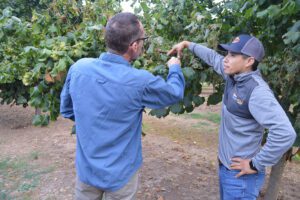
Researchers were using a larger droplet size than normal, one-sixteenth of an inch, to help extend the life of the droplet on a leaf, Walton said.
The drone, an XAG P150, includes an 18.5-gallon tank enabling growers to spray around 3.5 acres in a single pass at 5 gallons per acre and spray around 25 acres per hour.
Drones offer several advantages over conventional application equipment and their use in hazelnuts targeting eastern filbert blight and the filbert worm has increased in recent years, according to Chris Kaiser, manager of the Ag Services Department at Pratum Co-op.
“For growers, in the March and April time frame, it can be nearly impossible a lot of times to go out with a ground rig because it is still pretty muddy,” Kaiser said. “And a lot of times airplane companies get overbooked so the growers don’t get the applications on like they should be doing.”
Drones also can improve coverage over airplanes, Kaiser said, because they are able to reach tight areas that airplanes can’t. And he said applications can be done faster by drone than by ground application, meaning less labor is involved when comparing a ground application to a drone application.
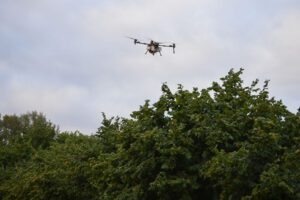
To date, hazelnut growers have largely targeted BMSB by applying bifenthrin through an airblast sprayer. Torres noted that Pratum and the OSU researchers are hoping to show that the formula they are testing can be equally effective against BMSB and less impactful on an orchard’s beneficial insect population. But he said they will need more data before they can confidently state that.
“We have to get good-quality data to be able to say, ‘Hey, we can control your BMSB with Delegate and an attractant,’” he said.
Judging from an initial observation, they may be able to start stating that sooner rather than later.
“We are seeing significant mortality in the spray plots,” Walton said on August 15, eight days after the initial treatment.







